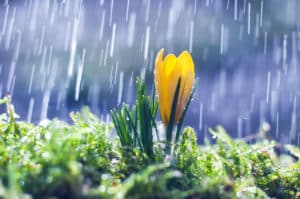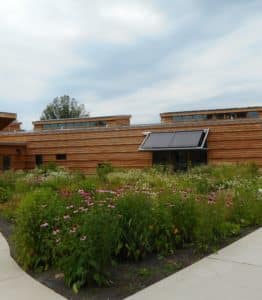

Do you know where water goes when it rains? If you’re like many people, you might assume that stormwater runoff is captured, treated at a water treatment plant, and then returned to waterways. But runoff from storms is actually not treated before it reaches waterways. Not only that, but it often picks up contaminants such as pesticides, oil, fertilizer, and other pollutants before emptying into local streams, rivers, and lakes.
Stormwater runoff isn’t typically treated because doing so is a costly, difficult endeavor that’s just not always possible. This untreated runoff is hugely detrimental to local water quality and can have an adverse impact on both drinking water supplies and the environment. Runoff contributes to erosion, the buildup of sediment, and can negatively impact freshwater ecosystems and environments. Pollution to stormwater is a result of many different, varied activities, which makes regulating it difficult, further complicating this widely misunderstood environmental issue.
Climate change also contributes to the problem of stormwater, with stronger storms happening on a more regular basis. To mitigate this issue, many cities have embraced a solution that is both aesthetically pleasing, yet practical: Commercial Rain Gardens.
In this blog post, we’ll explore Rain gardens in-depth and provide some insight into why they may be a beneficial addition to your project.
What Is a Commercial Rain Garden?
A commercial rain garden (also referred to as a rain garden) is a unique, depressed structure that is developed to capture stormwater and runoff from rooftops, streets, sidewalks, and other impervious surfaces so it can infiltrate the soil to recharge the groundwater. Rain gardens usually feature native water-loving plants, providing welcome resources for pollinating insects, while also filtering water. Rain gardens increase the appeal of urbanized areas while also providing pollinators with habitats and improving natural environments. In short, everybody wins!

Why Are Commercial Rain Gardens Important?
Rain gardens are important because they can collect polluted rain runoff and filter it through native plants and vegetation before it’s discharged into groundwater aquifers or storm drains. Filtering runoff before it makes its way back into waterways is critical so natural ecosystems can remain intact. The US EPA estimates that pollutants from rain runoff account for 70% of all water pollution, making stormwater management a necessity.
Solving the Problem of Stormwater with Nature-Based Solutions
While it’s impossible to control the weather, local municipalities can learn how to manage stormwater more effectively. It all starts with urban planning and civil engineering. City planners, engineers, developers, and local officials each play an integral role in helping to solve the problem of stormwater. The best place to start is right at the source and to evaluate how the land is used. How neighborhoods, streets, and parks are designed can help control how water flows into waterways, which can reduce the impact on local communities and environments.
This approach to stormwater management is commonly referred to as “green infrastructure” and includes everything from Rain Gardens to street trees to the permeable pavement, wet meadows, and others. By acknowledging the need for a type of infrastructure that can slow down and filter stormwater and runoff, this approach:
- Cleans the water by more effectively routing it through natural filters such as native plants and trees.
- Improves the aesthetic appeal of neighborhoods, while supporting essential wildlife.
- Contributes to decreased flooding, cleaner air, and reduced heat islands (areas that increase in temperature due to urbanization).
Communities are finally beginning to embrace green infrastructure as they recognize how it can aid in solving the problem of stormwater and runoff. Many are even redesigning parks to improve how they capture and manage stormwater. Some states, like Pennsylvania, are even incorporating green infrastructure into stormwater ordinances to increase the practice of these beneficial techniques.

Invest in a Commercial Rain Garden Today
At Carroll Engineering, we recognize the criticality of stormwater management. Effective stormwater management promotes healthier environments, decreased flooding, improved air quality, and more. And green infrastructure contributes to beautification and provides more recreational opportunities for residents, resulting in improved well-being for both people and the planet. Finally, managing stormwater can greatly reduce future costs, improve property values, and contribute to increased local tourism.
With all of these great benefits, we hope you now understand how stormwater management can benefit your community. To learn more about our planning and site design services and see how we can help you manage stormwater, learn more about our civil engineering planning & site design services.
Ready to get started on your next project? Contact us!
